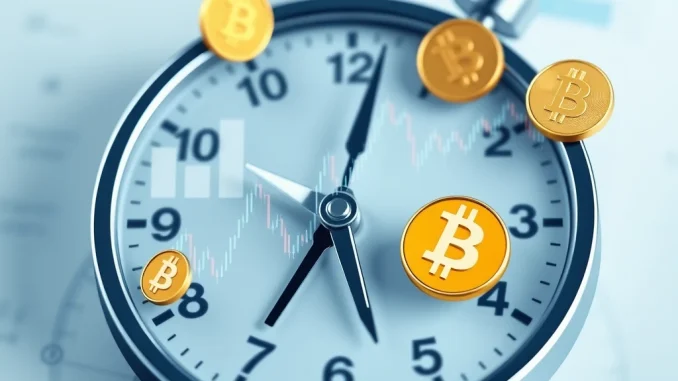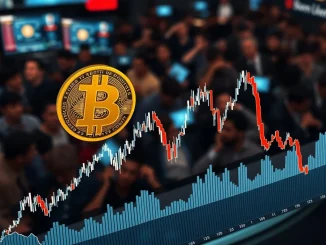
Why should cryptocurrency investors pay attention to economic calendars? While the crypto market operates 24/7 and often follows its own rhythm, it doesn’t exist in a vacuum. Macroeconomic factors, especially actions and commentary from central banks like the U.S. Federal Reserve, can significantly influence liquidity, investor sentiment, and ultimately, the price of Bitcoin, Ethereum, and other digital assets. Understanding upcoming economic events is crucial for navigating the week ahead.
Why Crucial Economic Events Matter for Your Crypto Portfolio
Traditional financial markets react strongly to economic data and central bank communications. Given the increasing correlation between crypto and traditional risk assets, these reactions often spill over into the crypto market. Key areas of impact include:
- Liquidity: Central bank policies (like interest rates and quantitative easing/tightening) directly affect the amount of money circulating in the economy. More liquidity can flow into riskier assets like crypto; less liquidity can cause investors to pull back.
- Risk Appetite: Economic data showing strength or weakness, or signals from central bankers, can increase or decrease investor confidence and willingness to invest in volatile assets.
- Inflation Expectations: Data related to inflation is closely watched, as it heavily influences central bank decisions on interest rates. High inflation often leads to tighter monetary policy, which can pressure crypto prices.
This week presents several key dates and announcements that crypto investors should be aware of.
Who Are These Fed Speakers and Why Listen?
A significant portion of this week’s schedule involves speeches from members of the U.S. Federal Reserve. These aren’t just random talks; they are opportunities for central bankers to communicate their views on the economy, inflation, and the potential path of monetary policy. The speakers listed – including FOMC Members Williams, Bostic, Kashkari, Kugler, Daly, and Fed Governors Jefferson, Logan, Collins, Cook – are key decision-makers or influencers within the Fed system.
Their comments can provide clues about:
- Whether the Fed is leaning towards raising, holding, or cutting interest rates.
- Their outlook on inflation and employment.
- Their perspective on the overall health of the U.S. economy.
Even subtle shifts in language can move markets. While not official policy announcements, these speeches shape expectations, which in turn affects trading behavior in both traditional finance and the crypto market.
Key US Economic Data: Initial Jobless Claims Explained
On Thursday, the U.S. releases Initial Jobless Claims data. This report measures the number of people who filed for unemployment benefits for the first time during the previous week. It’s a timely indicator of the health of the labor market.
Why does this matter?
- A low number of claims suggests a strong job market, which can contribute to wage growth and potentially fuel inflation. This might signal the Fed needs to keep interest rates higher.
- A high number of claims suggests a weakening job market, which could indicate slowing economic growth or potential recession. This might pressure the Fed to consider cutting interest rates to stimulate the economy.
Unexpected movements in this data can lead to market volatility, impacting the broader financial landscape that includes the crypto market.
Beyond the US: China’s PBoC and Global Impact
While the focus this week is heavily on the U.S. Fed, Tuesday brings an important announcement from China: the PBoC Loan Prime Rate (LPR). The People’s Bank of China (PBoC) sets these benchmark lending rates.
Changes to the LPR signal the PBoC’s stance on monetary policy – whether they are easing (cutting rates to stimulate) or tightening (raising rates to cool down). Given China’s significant role in the global economy and its historical connection to the crypto industry (mining, trading volume), decisions from the PBoC can have ripple effects felt in the global crypto market.
Navigating the Week Ahead: Actionable Insights
Here is the schedule of key economic events to monitor this week (All listed times are in UTC):
| Date | Time (UTC) | Country | Event | Significance |
|---|---|---|---|---|
| Sunday, May 18 | 21:20 | U.S. | FOMC Member Williams Speaks | Insights on monetary policy outlook. |
| Monday, May 19 | 12:30 | U.S. | FOMC Member Bostic Speaks | Views on economy and rates. |
| Monday, May 19 | 12:30 | U.S. | FOMC Member Williams Speaks | Further commentary from a key member. |
| Monday, May 19 | 13:45 | U.S. | Fed Governor Jefferson Speaks | Perspective from a Fed Governor. |
| Monday, May 19 | 17:15 | U.S. | Fed Logan Speaks | Regional Fed President’s economic views. |
| Monday, May 19 | 17:30 | U.S. | FOMC Member Kashkari Speaks | Often provides hawkish or dovish insights. |
| Tuesday, May 20 | 01:15 | China | PBoC Loan Prime Rate | China’s benchmark interest rates decision. |
| Tuesday, May 20 | 13:00 | U.S. | FOMC Member Barkin Speaks | Regional Fed President’s economic views. |
| Tuesday, May 20 | 13:00 | U.S. | FOMC Member Bostic Speaks | Another opportunity for commentary. |
| Tuesday, May 20 | 13:30 | U.S. | Fed Collins Speaks | Regional Fed President’s economic views. |
| Tuesday, May 20 | 21:00 | U.S. | FOMC Member Kugler Speaks | Perspective from a Fed Governor. |
| Tuesday, May 20 | 23:00 | U.S. | FOMC Member Daly Speaks | Regional Fed President’s economic views. |
| Wednesday, May 21 | 16:00 | U.S. | FOMC Member Barkin Speaks | Further commentary. |
| Thursday, May 22 | 12:30 | U.S. | Initial Jobless Claims | Key labor market indicator. |
| Thursday, May 22 | 18:00 | U.S. | FOMC Member Williams Speaks | Closing out the week with Fed commentary. |
| Friday, May 23 | 16:00 | U.S. | Fed Governor Cook Speaks | Perspective from a Fed Governor. |
Actionable Insight: While predicting exact market movements is impossible, being aware of these dates allows you to anticipate potential volatility windows. Pay attention to headlines reporting on the content of the Fed speeches and the jobless claims data. Look for commentary on inflation, labor market strength, and future plans for interest rates. These are the signals most likely to impact the broader financial environment and, consequently, the crypto market.
Summary
This week’s calendar is packed with insights into the U.S. economic outlook and monetary policy via numerous Fed speakers, plus a look at China’s policy via the PBoC. The U.S. Initial Jobless Claims report will offer a key data point on the labor market. For anyone invested in the crypto market, monitoring these economic events is vital. They provide valuable context for understanding shifts in market sentiment, potential changes in liquidity, and the ongoing battle against inflation and decisions around interest rates that continue to shape the financial world.



